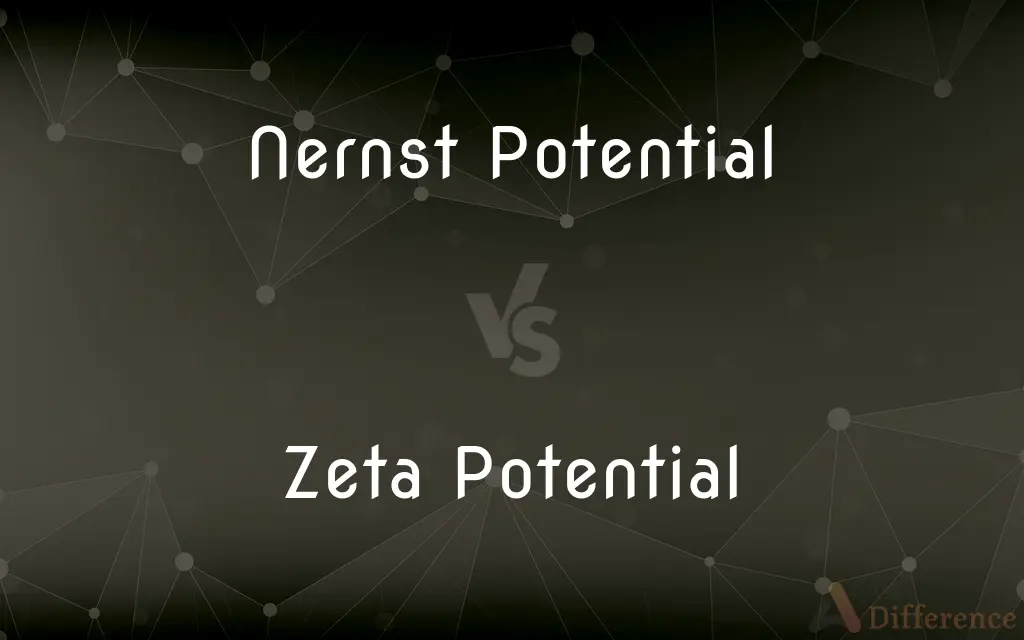Nernst Potential vs. Zeta Potential — What's the Difference?
By Tayyaba Rehman — Published on November 12, 2023
Nernst Potential is the electric potential across a cell's membrane at equilibrium, affecting ion distribution. Zeta Potential is the electrical charge at the interface between a solid particle and its liquid medium, affecting particle dispersion.

Difference Between Nernst Potential and Zeta Potential
Table of Contents
ADVERTISEMENT
Key Differences
Nernst Potential, within the cellular physiology context, plays a crucial role in dictating the ion concentration across a cell membrane. Zeta Potential, on the contrary, plays a fundamental role in colloidal science, influencing the stability of colloidal systems. While both potentials involve some degree of ion interactions, they fundamentally apply to different scientific fields and phenomena.
The realm of Nernst Potential predominantly concerns itself with cellular membrane potential, particularly when no net ion movement occurs across the semi-permeable membrane. Zeta Potential diverges here, as it specifically addresses the electrokinetic potential in colloidal dispersions, substantially impacting colloidal stability. Thus, their core applications reside in disparate scientific sectors, from cellular biology to physical chemistry.
Nernst Potential is an equilibrium potential, symbolizing the precise membrane potential at which there is no net ion flux across the membrane due to diffusion. In a stark contrast, Zeta Potential isn’t associated with cellular membranes but with the dispersion or aggregation propensity of particles in a colloidal system, indicating the degree of repulsion or attraction between adjacent, similarly charged particles.
Although Nernst Potential involves ions, it directly relates to cell and neuron functioning by establishing the resting membrane potential that is critical for cellular activities like neurotransmission. Zeta Potential, while also involving ions, addresses how dispersed or aggregated particles will be within a suspension, which can be crucial in industries like pharmaceuticals and wastewater treatment where particle suspension stability is pivotal.
In terms of practicality and utility, the Nernst Potential helps in understanding the electrochemical states of cells, especially in physiological and pathological scenarios. Meanwhile, the Zeta Potential aids in comprehending and manipulating colloidal and surface chemistry, ensuring the stability and usability of suspensions in various industrial and research applications.
ADVERTISEMENT
Comparison Chart
Primary Application
Cellular Physiology
Colloidal Science
Context of Utilization
Across cell membranes
At the interface between a particle and its liquid medium
Impact
Influences ion concentration and distribution across the cell membrane
Influences the stability and dispersion/aggregation of particles in a colloid
Associated Phenomena
Neurotransmission and cellular activities
Particle charge and suspension stability
Measurement Context
Typically involves biological membranes
Involves measuring in a colloidal dispersion
Compare with Definitions
Nernst Potential
Nernst Potential is calculable using the Nernst equation, accounting for ion concentrations inside and outside a cell.
By accurately measuring ion concentrations, researchers can use the Nernst equation to predict a cell's potential concerning specific ions.
Zeta Potential
Zeta Potential indicates the electrokinetic potential in colloidal systems.
By optimizing Zeta Potential, scientists can enhance the stability of nanoparticle suspensions in drug delivery systems.
Nernst Potential
Nernst Potential assists in understanding how cells achieve electrical neutrality and ion equilibrium.
Studying the Nernst Potential aids in deciphering how cells maintain homeostasis despite varying ion concentrations.
Zeta Potential
Zeta Potential is pivotal in predicting and controlling the stability of colloidal suspensions.
The monitoring of Zeta Potential is essential in wastewater treatment to ensure the stability of particulate suspensions.
Nernst Potential
Nernst Potential quantifies the voltage across a membrane when a particular ion is in electrochemical equilibrium.
The sodium-potassium pump helps maintain the Nernst Potential essential for nerve cell excitability.
Zeta Potential
Zeta Potential reveals the charge that particles in a colloidal dispersion exhibit.
High Zeta Potential values imply that particles will repel each other, promoting dispersion within the colloidal system.
Nernst Potential
Nernst Potential highlights the relationship between ion gradients and electrical forces across cellular membranes.
Disturbances in the Nernst Potential may lead to pathological conditions like seizures due to ion imbalance.
Zeta Potential
Zeta Potential guides the comprehension of particle interactions in dispersed systems.
In formulations, a balanced Zeta Potential helps prevent unwanted aggregation of particulate matter, ensuring product consistency.
Nernst Potential
Nernst Potential is the membrane potential at which an ion does not net flow across the membrane due to its concentration gradient and electrical force.
Potassium ions tend to have a Nernst Potential of approximately -75 mV in mammalian cells.
Common Curiosities
What is the Nernst Potential?
The Nernst Potential refers to the voltage across a membrane when a particular ion type is at electrochemical equilibrium.
How does the Nernst Potential relate to neuronal function?
Nernst Potential helps in establishing the resting membrane potential in neurons, crucial for maintaining and regulating neurotransmission.
Can Zeta Potential impact product formulation in the pharmaceutical industry?
Yes, Zeta Potential plays a crucial role in ensuring the stability of formulations, preventing unwanted aggregation of particulate matter, and ensuring product consistency.
What is the primary application of the Nernst Potential?
Nernst Potential is mainly applied in cellular physiology, especially in understanding ionic balance across cellular membranes.
Is it possible to measure Zeta Potential in complex fluids?
Yes, Zeta Potential can be measured in complex fluids, although careful consideration must be given to factors like ionic strength and pH.
How is the Nernst Potential calculated?
Nernst Potential is calculated using the Nernst equation, considering the temperature and the ion concentrations on both sides of the membrane.
Is the Nernst Potential affected by temperature variations?
Yes, the Nernst Potential is affected by temperature, as temperature is a variable within the Nernst equation.
How does Zeta Potential differ from Nernst Potential?
Zeta Potential measures the electrical charge at the interface between a solid particle and its liquid medium, crucial in colloidal stability, whereas Nernst Potential pertains to ion equilibrium across cellular membranes.
In which scientific domain is Zeta Potential predominantly utilized?
Zeta Potential is widely utilized in colloidal science, helping understand and control the stability of colloidal systems.
How does pH influence Zeta Potential?
pH can influence Zeta Potential by altering the surface charge of particles in dispersion, which subsequently affects their interaction and stability.
Why is Zeta Potential vital in industrial processes?
Zeta Potential is vital in various industries, such as pharmaceuticals and wastewater treatment, as it aids in determining the stability and dispersion/aggregation of particles in a colloid.
In what practical applications is Zeta Potential relevant?
Zeta Potential is relevant in applications such as drug delivery, where nanoparticle stability is crucial, and in wastewater treatment for effective flocculation and coagulation processes.
In what biological contexts is Nernst Potential studied?
Nernst Potential is studied in various biological contexts, like neurotransmission, muscle contraction, and cellular homeostasis, due to its role in ion balance.
Does Nernst Potential play a role in pathological conditions?
Yes, alterations or disturbances in the Nernst Potential, leading to ion imbalances, can contribute to pathological conditions like seizures or muscle spasms.
What ions are typically considered when calculating the Nernst Potential?
Ions like potassium, sodium, calcium, and chloride are typically considered when calculating the Nernst Potential, given their physiological relevance.
Share Your Discovery

Previous Comparison
ALT vs. AST
Next Comparison
PlayStation 2 vs. PlayStation 3Author Spotlight
Written by
Tayyaba RehmanTayyaba Rehman is a distinguished writer, currently serving as a primary contributor to askdifference.com. As a researcher in semantics and etymology, Tayyaba's passion for the complexity of languages and their distinctions has found a perfect home on the platform. Tayyaba delves into the intricacies of language, distinguishing between commonly confused words and phrases, thereby providing clarity for readers worldwide.
















































